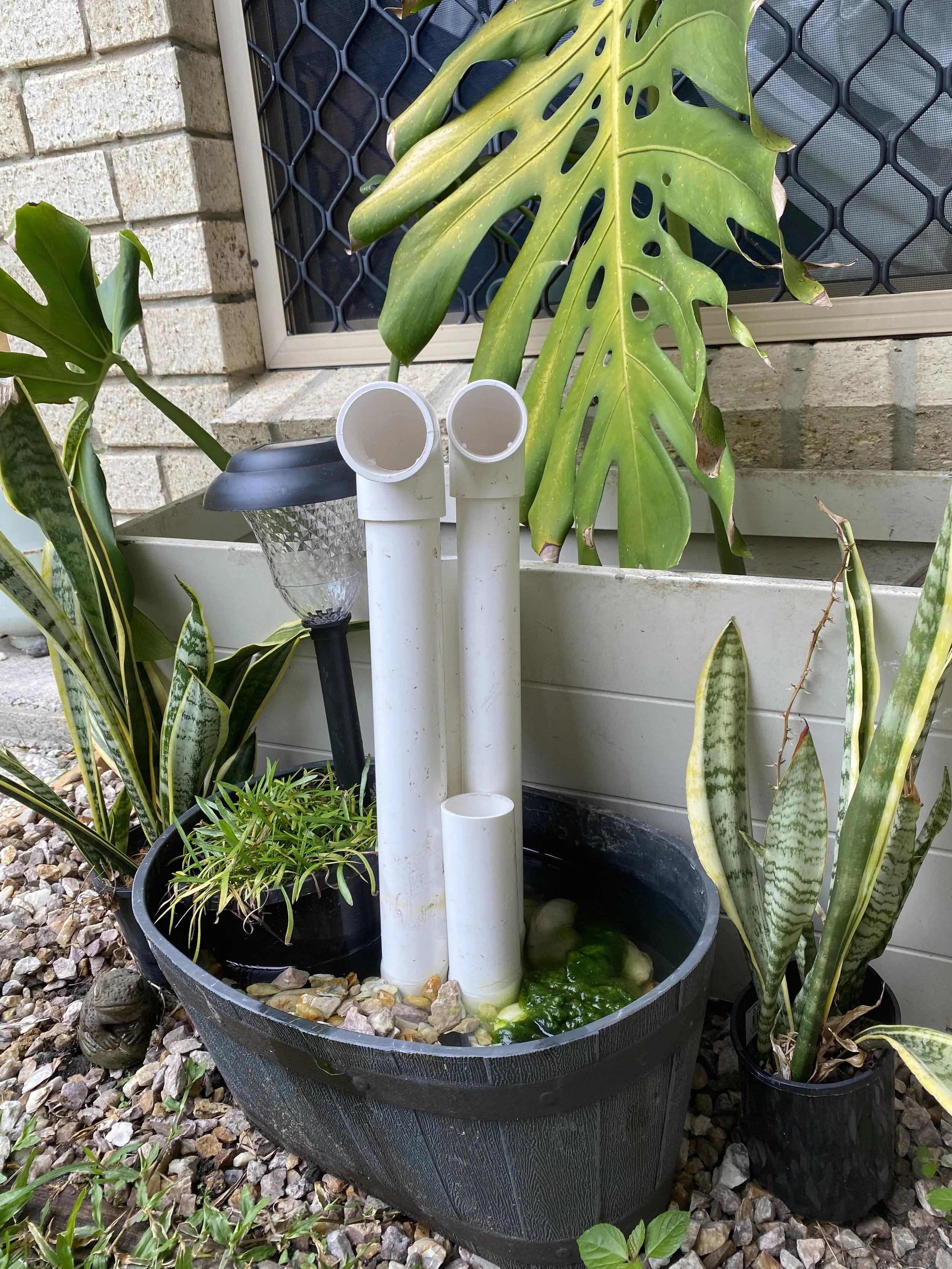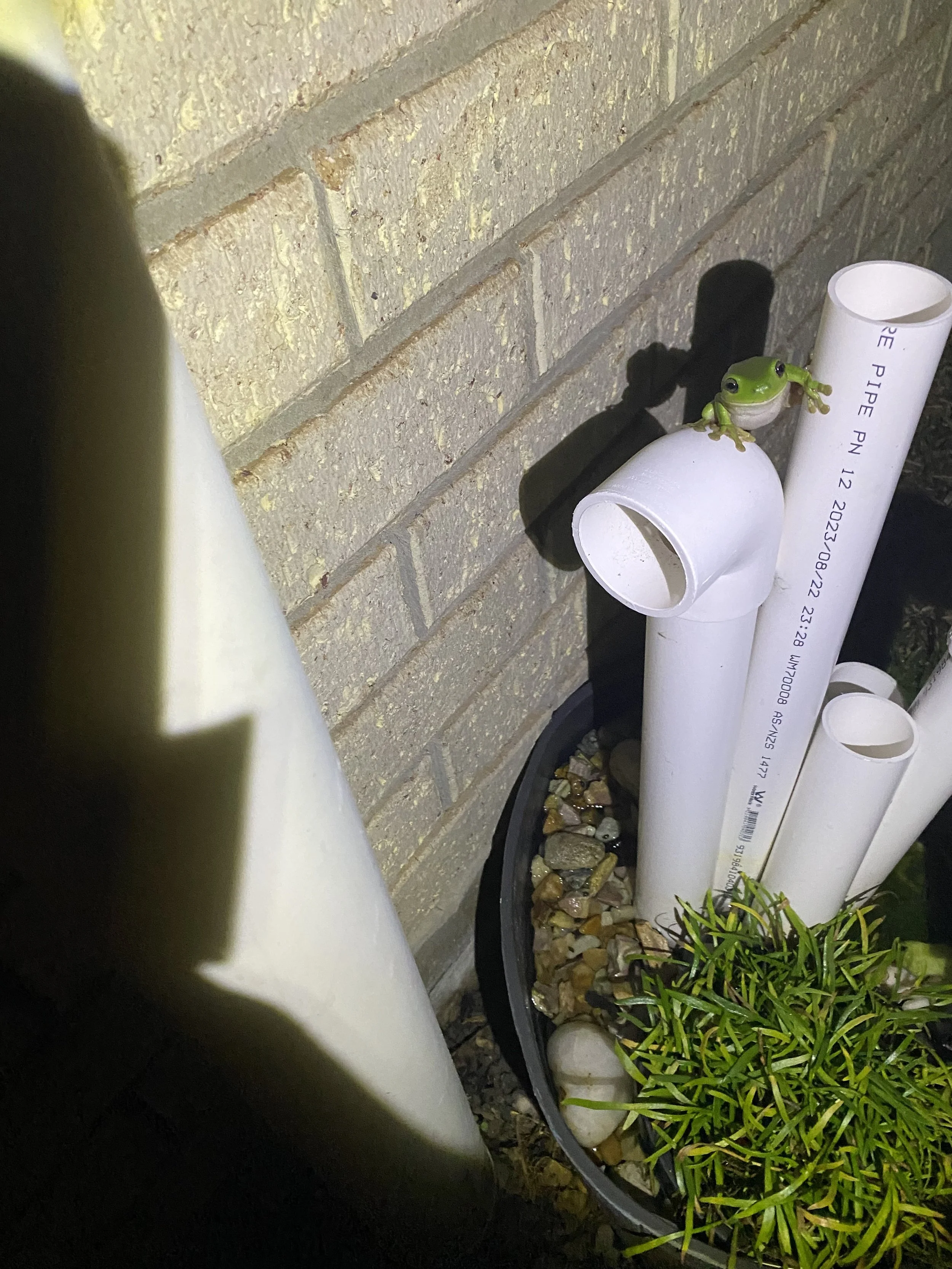Build a Frog Hotel: A Fun, Educational Project for the Family
Creating a frog hotel in your backyard is an engaging way to connect with nature and teach your children about local wildlife.
This simple project not only provides a safe haven for frogs but also helps kids learn about the importance of biodiversity and conservation.
Plus, it's a wonderful way to encourage curiosity about the natural world right in your backyard.
Here’s a step-by-step guide to building your very own frog hotel.
DID YOU KNOW?
Habitat loss and habitat degradation are the two biggest threats facing frogs in Queensland.
Materials You’ll Need:
PVC pipes in 3-4 different widths: These will serve as the main structure of your frog hotel.
A bowl or tub to hold water: Ensure it’s watertight. If it has a drainage hole, seal it with silicone.
Small gravel or pebbles: To stabilise the pipes and create a natural look.
Optional Additions:
Native water plants: These will enhance the hotel’s environment.
Large river stones or decorative rocks: For added aesthetic appeal.
Solar light: To attract insects at night, providing food for your frogs.
Step-by-Step Instructions:
Step 1: Prepare the Pipes
Cut the PVC pipes into varying lengths to create a more natural look, and sand the edges smooth to remove any sharpness.
Step 2: Arrange the Pipes
Place the pipes upright in your chosen bowl or tub, arranging them to create an inviting space for frogs.
Step 3: Secure the Pipes
Have someone hold the pipes steady while you fill the bowl with gravel or pebbles, ensuring the pipes stand upright. You can also add some gravel inside the pipes for extra stability.
Step 4: Add Water Plants (Optional)
If you’re using water plants, place them in the bowl, making sure the rim of the plant pot sits just below the edge of the outer bowl.
Step 5: Fill with Decorative Elements
Add more gravel, decorative rocks, or river stones around the pipes to fill out the bowl.
Step 6: Add Water
Fill the pipes and the bowl with water. Your frog hotel is now ready to welcome its new guests!
Additional Tips for Your Frog Hotel:
Attracting Frogs: Consider adding a solar light to attract insects at night, providing a food source for the frogs.
Keeping Cane Toads Away: Place the frog hotel at least 60 cm off the ground to deter cane toads. Tree frogs, the intended guests, can easily climb up.
Water Maintenance: Check your frog hotel every few days and top up the water as needed. Use chlorine-free water, which you can create by letting tap water sit for 24 hours or by using a water conditioner from a pet store.
Preventing Mosquitoes: Fill the water just up to where the rocks and pebbles start to minimize mosquito activity. Flush out the water every 3-4 days to keep it fresh.
Choosing Plants: Opt for frog-friendly native plants that thrive in wet conditions, such as common rush (Juncus usitatus), bog primrose (Villarsia exaltata), native violet (Viola hederacea), or frogsmouth (Philydrum lanuginosum).
DID YOU KNOW?
Queensland has 132 species of frog, more than any other Australian state
Frogs You Might Attract in South-East Queensland:
Green Tree Frog (Ranoidea caerulea): These iconic bright green frogs are common and love hanging out around homes and gardens.
Eastern Dwarf Tree Frog (Litoria fallax): Small and often green or brown, these frogs are frequent visitors to wet grasslands and garden ponds.
Graceful Tree Frog (Ranoidea gracilenta): Often found in various habitats, including rainforests, woodlands, and near human developments, it may enter houses or hitch a ride on fruits and vegetables.
Great Barred Frog (Mixophyes fasciolatus): With distinctive black bars on its legs, it is almost always found near running water. It breeds in streams and ponds, using its strong legs and webbed feet to quickly escape predators by leaping into the water.
Other common species include: Striped Marsh Frog (Limnodynastes peronii), Ornate Burrowing Frog (Platyplectrum ornatum), and the Eastern Stony-creek Frog (Ranoidea wilcoxii)
Froggin’ Fun: How Kids and Citizen Scientists Can Make a Difference
Citizen science is an exciting way for everyday people, including kids, to contribute to real scientific research. By observing and recording data about the world around them, young citizen scientists can play a crucial role in helping experts monitor and understand various aspects of the environment. This hands-on approach to learning is not only educational but also incredibly rewarding, as it allows children to see how their contributions can make a real impact.
Incorporating citizen science into your child’s activities is a fantastic way to deepen their connection with nature while fostering a sense of responsibility and curiosity. One great example is using the FrogID app to upload recordings of frog calls and observations from your frog hotel.
FrogID is the Australian Museum's national citizen science project that is helping scientists learn more about what is happening to Australia’s frogs. All around the country, people are recording frog calls with the free FrogID app for frog call experts to listen and verify. Fun fact: people who upload frog calls are referred to as ‘froggers’!
By participating in this project, your child can help scientists track frog populations and contribute to important conservation efforts. It's a fun and meaningful way for kids to be part of something bigger while learning about the natural world around them.
Creating a frog hotel is more than just a fun backyard project—it’s a way to bring your family closer to nature, foster a love for the environment in your children, and contribute to local conservation efforts.
Plus, it’s a wonderful opportunity to observe these fascinating creatures up close, right from the comfort of your home. So gather your materials, get outside, and start building your frog hotel today!
Here are other ways we can help your kids connect with nature:
Make the Most of School Holidays: Book Your Spot in Our Adventure-Packed Holiday Program Today!
Celebrate in the Wild: Reserve Your Child's Unforgettable Birthday Party with Us!
Bring the Classroom Outdoors: Schedule an Inspiring School Excursion or Incursion with Wildlings Forest School!
Written by Ellen Nesbitt. Ellen is a nature play advocate and creative writer with a passion for helping families connect with the outdoors. She is dedicated to exploring ways to nurture children's creativity, independence, wellbeing and love for nature.


